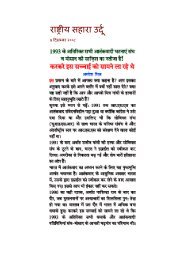Shastra Poojan - Indiannationalism.org
Shastra Poojan - Indiannationalism.org
Shastra Poojan - Indiannationalism.org
You also want an ePaper? Increase the reach of your titles
YUMPU automatically turns print PDFs into web optimized ePapers that Google loves.
which agriculture scientists are invited to guide the<br />
farmers. The government officers of different<br />
departments are called in the village to discuss the<br />
problems of farmers on regular basis.<br />
Besides other animals the village has over 3000<br />
cows and 154 bio-gas plants. The pressure of biogas<br />
is more than the LPG. It is also less sensitive<br />
than the LPG. “Bio-gas plant has changed our life<br />
beyond our imagination. Now there is no tension<br />
of purchasing LPG cylinder or cutting the woods<br />
from the forests. It is also very cheap. It solved all<br />
our energy and power problems,” said seventh<br />
pass Smt. Pratibha Chauhan in Samskrit. She<br />
pointed out that the cow dung produces more biogas<br />
than any other animals’ dung in the plant. The<br />
villagers have adopted Deenbandhu model of biogas<br />
plant, which requires less space and less cost.<br />
All plants are built underground and the space<br />
over them is used mostly for animals. According<br />
to Shri Bhaiyaji one plant of 2, 3, 4 and 6 cubic<br />
metres costs around Rs 10,000, 12,000, 14,000 and<br />
Rs 16,000 respectively. This model has proved<br />
very successful. That is why following requests<br />
from other villages the artisans of this village go to<br />
different states to build similar plants. Now the<br />
work is on in the village over the experiments of<br />
running diesel engines with bio-gas and storing it<br />
in cylinders too. Bio-gas plants have proved to be<br />
a milestone in protecting the environment and<br />
forests. Tying rakhi on trees by girls has also been<br />
taken up as a step to protect them.<br />
Till 15 years back, the people from dalit<br />
communities and Vanvasis were not allowed to<br />
have even drinking water from the public<br />
handpumps and wells. But now the picture has<br />
changed. All people belonging to any community<br />
can have water from any handpump or well<br />
freely. The village Panchayat has ensured at least<br />
one handpump at every 100-meter distance. The<br />
social harmony has improved to the extent that all<br />
villagers jointly perform bhajan-keertan in temples<br />
and have meals together. Those people who were<br />
earlier deprived of performing aarti during the<br />
Durga Pooja and Ganesh festivals now happily do<br />
it along with other villagers. Kanyapujan is also<br />
held in the village to bridge the gap between the<br />
upper and lower classes during Navratras.<br />
Adarsh Hindu Ghar competition is held in the<br />
village every year. A few years back, this award<br />
was won by a Jatav family of Shri Devkaran Jatav.<br />
RSS Sarsanghachalak Shri K.S. Sudarshan and the<br />
late BJP leader Saheb Singh Verma jointly visited<br />
the village to present the award to this family on<br />
11-4-2000. Writing Om or the sign of Swastik<br />
outside every house and having a tulsi plant in the<br />
premises is part of the 21-point programme under<br />
this competition, which is followed by all.<br />
The village has four schools including one<br />
Saraswati Shishu Mandir. Every child of the<br />
village goes to school and those who are below<br />
three years of age go to balwadis. All the schools<br />
begin with Saraswati Vandana and Vande<br />
Mataram. Interesting part of it is that even the<br />
Muslim students sing Saraswati Vandana and<br />
Vande Mataram without hesitation. They also sing<br />
Samskrit shlokas along with other students. Every<br />
house has the Ramayana and the Gita and the<br />
family members read them regularly. But the<br />
family members of one Jumman reads the Quran.<br />
Special attention is paid to improve<br />
handwriting of the students. Apart from personal<br />
efforts on the part of Shri Bhaiyaji who still writes<br />
very beautifully, Shri Nana Labhe, a handwriting<br />
expert, is invited from Nagpur to teach the<br />
techniques of improving handwriting. So far, he<br />
has visited the village nine times since 1996.<br />
Mohad has set a noteworthy example on<br />
Samskrit propagation. The first Samskrit<br />
Sambhashan Varga was held on January 15, 1996<br />
and so far six such Vargas have been <strong>org</strong>anised by<br />
the Samskrit Bharati. More than 800 persons<br />
including children have learnt Samskrit in these<br />
Vargas. There are more than 100 minor children,<br />
who can introduce themselves fully in Samskrit. A<br />
woman, Smt. Pramila Devi, even topped the All<br />
India Kovid Exam of Samskrit, conducted by<br />
Samskrit Bharati in 2004, with 84 per cent marks.<br />
Under Udyan Utsava school children are taken<br />
to village nursery twice a year and are taught<br />
about grafting. According to Shri Bhagvendra<br />
Patel, suprintendent of the nursery, the nursery has<br />
more than two lakh saplings of rare species.<br />
Special experiments of grafting are undertaken<br />
here. It has a variety of mango trees, which<br />
6



![tks fgeky; lk Ĺapk] xaxk lk fouez gks](https://img.yumpu.com/26586052/1/184x260/tks-fgeky-lk-lapk-xaxk-lk-fouez-gks.jpg?quality=85)

